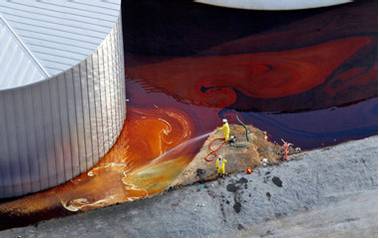
Incident Report Subject: USA, Stolthaven, Braithwaite Terminal may have released more than 191,000 gallons of toxic chemicals during Isaac Date of Email report: Mon 17/09/2012 Report Detail:
Workers at the Stolthaven chemical holding and transfer facility in Plaquemines Parish Thursday September 13, 2012. The company admitted to releasing more chemicals during Hurricane Isaac than initially thought. A report by Stolthaven to the National Response Center admits to releasing over 191,000 gallons of benzene, styrene, toluene and other chemicals into flood waters that entered Braithwaite, according to the Louisiana Bucket Brigade.
"This investigation is still ongoing by DEQ and numerous state, federal and local officials. "DEQ and others continue to monitor the air and have taken surface water samples and are reviewing plans to conduct soil samples," he said. "The current goal of all the responding parties is to clean up the facility and ensure public safety. Pre and post-storm reconciliation of the materials that were on site will better determine the actual amount released." A flyover of the area by a Times-Picayune photographer this morning showed a significant quantity of liquid material adjacent to one of the tanks, with nearby workers dressed in clothing designed to protect them from hazardous chemicals. "We know there were releases early in the event," Mallet said. "That's one of the reason for the extensive air monitoring which currently shows no off site impacts. The earlier releases are also one reason why we are in the process of beginning sediment sampling." The area around the terminal along Louisiana 39 in Plaquemines Parish remains blocked to residential traffic as a precautionary measure as workers move volatile chemical containers back into place. On Monday, DEQ emergency response manager Peter Ricca said any hazard remained on the facility's site. Company officials said then that the facility sustained severe flooding during Isaac, with parts of the plant under 7 feet of water. However, in the report, company officials said floodwaters were between 10 and 14 feet deep "which caused damages and leaks to some of the storage tanks." "The release occurred on 29Aug2012 with the discovery date of 11Sep2012," the form said. "The quantities for all of the materials involved are not expected to exceed the specified amount." Officials with the Louisiana Bucket Brigade said the report raises questions about DEQ's public reassurances. "As of a few days ago, DEQ was offering assurances of safety to people, and this form exposes how lackadaisical they are about protecting us, and they should be fired," said Anne Rolfes, the group's executive director. "They were saying publicly that it was safe and nothing was released into the greater community, but it was clear from just driving through the neighborhood that something was wrong. They need to be honest and not just give kneejerk reassurances." Rolfes said the report also shows that Stolthaven did not do enough to prepare for an expected flooding of its facility during the storm. "They'll say that Isaac was an act of God, but they're supposed to be prepared to withstand floodwaters," she said. DEQ and Stolthaven officials did not respond Thursday afternoon for comments on the report. Stolthaven officials reported the release of nine toxic chemicals into floodwaters:
Additional Documentation:
|

